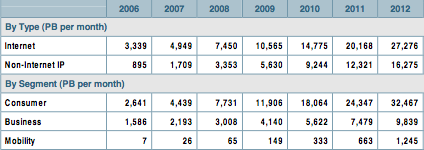Video Is Not The Future of the Internet. It’s the Present.

Auto companies may be going out of business. The Dow Jones Industrial Average is shrinking dramatically, by the day. Consumer confidence is at a post-war low. But Internet traffic is unabated.
Notably, it’s led by consumers. And video.
"We are living in unprecedented times,’’ noted Kelly Ahuja, senior vice president and general manager of the service provider routing technology group at Cisco Systems, at the UBS Global Technology and Services Conference Thursday. But, he soon added, "there is lots of traffic growth."
"The majority of the traffic growth is occurring in the consumer space, driven by consumer Internet or video, whether it is IPTV or frankly even video over the Internet," he said.
Here are Cisco’s basic numbers, from a study released in June.
Consumer traffic is more than double business traffic and will be more than triple business traffic in 2012.
And traffic generated by consumers on the open Internet will nearly quadruple in the next four years.
So, by then, video will be the dominant source of traffic, right?
Right. But it also already is.
Cisco doesn’t include peer-to-peer file sharing when it says that video will account for a quarter of consumer traffic on the Internet this year. But that’s hardly the case.
Roughly the equivalent of 500 million DVDs are being shared every month over P2P networks. If you figure 65 percent of the 2,361 petabytes of data that are being shipped each month from peer to peer comes from video sharing, there is no question that video now dominates Internet traffic.
The following chart takes an estimate from Cisco senior market analyst Arielle Sumits that 65 percent of P2P traffic in 2008 is due to consumer sharing of videos. And it uses her estimate that 95 percent of P2P traffic will be derived from video in 2012, when high-definition video has taken greater root.
Web browsing, email transport and basic data exchange will account for just 16% of traffic (not shown). It’ll be roughly the equivalent of the amount of traffic generated by Internet video going directly to TV screens. And video going to PC screens and file-sharing will far outweigh what is perceived today to be the fundamental uses of the Internet.
Video in 2012 will account for more than three-fourths of all consumer traffic on the Internet. But that future is far closer to now than you may think. More than 60 percent of today’s consumer traffic is from video, in all its forms of transit.
Now, the economy has taken a nose dive since this study was completed. And Internet service providers have not been hesitant to tell Ahuja what they think of the study’s traffic growth projections.
‘The smart ones look at us and go, well, you’re right. But you’re way off. They think we’re conservative,’’ he said.
Now, the more traffic the better for Cisco, so it should hope that’s right. It’s been kind of a tough week and bad month for John Chambers and crew.
So, if it’s true that the hour between 8 p.m. and 9 p.m. at night is now becoming the Internet’s prime time, too, that could help its comeback from this latest economic bust. The Internet can’t be a collection of dumb pipes, at this point, argues senior manager of service provider marketing Thomas Barnett. Providers of Internet access will routinely have to prioritize traffic -- read: in favor of video -- if they are going to provide a "quality of experience" that allows them to charge for that access.
And somehow competes with the experience being provided by the closed networks of cable and satellite TV.
After all, nearly 80 percent of the traffic they handle will be coming from video when Barack Obama (backed by his cadre of the Web savvy) runs for re-election as president.
Of course, 60 percent already does.
